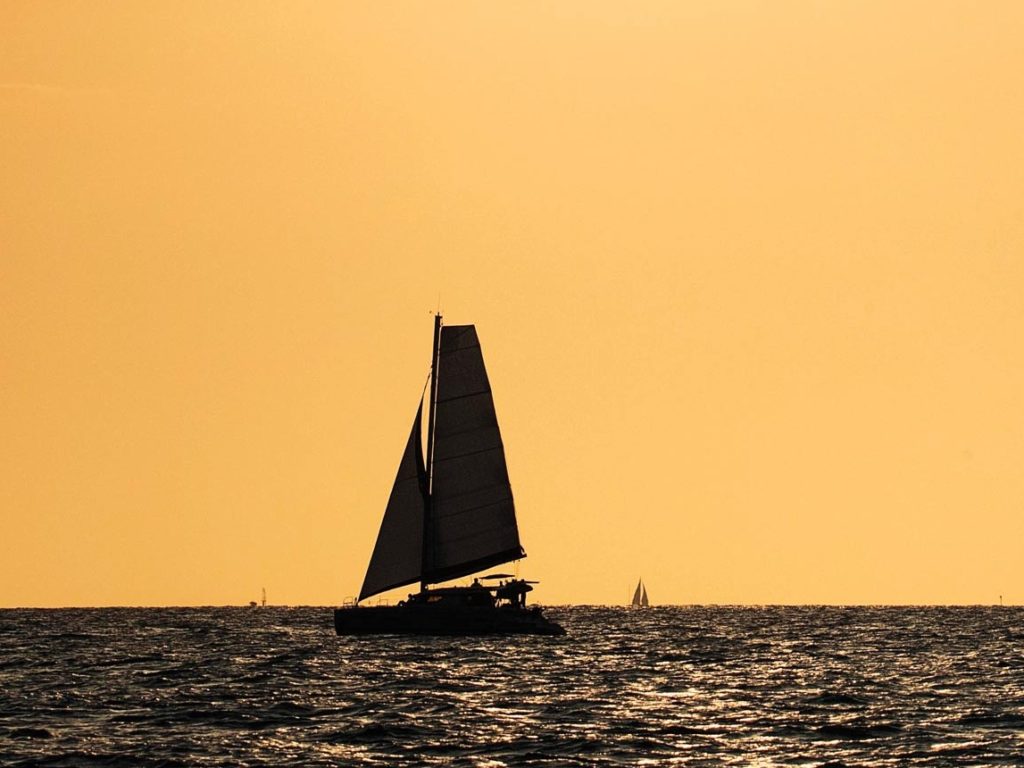
“So, what do you guys want to listen to?” asked our new friend, Cuban artist Solé.
“I don’t know, maybe something local?” replied Mark.
“How about Simply Red?” was Solé’s reply. “Do you guys like Simply Red?”
This might be the last thing I expected him to say, but at this point, nothing really could surprise me. And so he popped in a Simply Red CD while the group of us sat around the living room, sipping strong Cuban coffee in the tiny Havana apartment he shared with his wife, Mary, and her family. All I could do was look around me and smile at the unexpectedness of it all. We were midway through our time in the island nation during the 2017 Cruising World Expedition and Rally to Cuba, sponsored by Fountaine Pajot, and from the very beginning, this country had surprised me in so many ways.
The brainchild of my friend and colleague David Gillespie, the rally came to fruition in late March 2017 after a year of legwork and planning. In all, 49 private sailboats and 10 chartered sailboats met up at Stock Island Marina in Key West, Florida, to begin the adventure. Our home for the week was Quince Amor, a chartered Fountaine Pajot Saba 50 catamaran, and our cast of characters included myself and my husband, Green; David and his wife, Sandy; and photographer and troublemaker Jon Whittle. Also aboard the five-cabin cat were two brokers from Atlantic Cruising Yachts, the largest North American dealer for Fountaine Pajot catamarans: Frank McCarthy and his wife, Janet, and Joe Buxton and his wife, Mary. Editor-in-chief Mark Pillsbury rounded out team Cruising World aboard Tranquility Base, a beautiful Fountaine Pajot Ipanema 58 also participating in the rally.
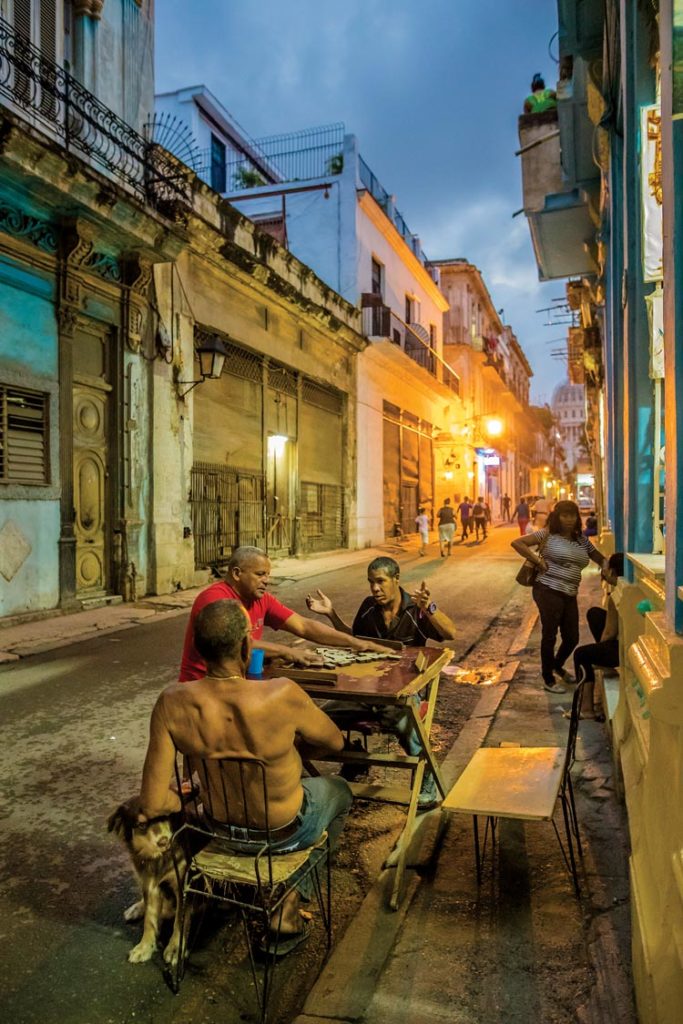
While sailing to Cuba and traveling in the country certainly was something I wanted to experience as part of my role as a Cruising World editor, visiting the island held a strong personal note as well. With both Green and me growing up in South Florida and around so much Cuban culture, we have been intrigued by Cuba for a very long time. Politics and regulations being what they are, the island nation has always been just out of our reach, merely adding to the mystique. When David started putting the plans in motion to work with a charter company and make this rally a reality, I jumped at the chance to participate. Although things had been getting easier for cruisers to take their own boats to Cuba, there was still plenty of red tape, which made going with a rally — and letting someone else deal with the paperwork — seem like an ideal way to finally do the trip. For the latest Cuba visitor regulations see Cuba Rules.
Green, David, Sandy and I headed to Key West on Tuesday, March 28, to arrive well ahead of the planned March 30 departure, and to have time to provision, attend the captains’ briefing and meet some of the other crews. Although we work for the same company, albeit in different states, I had never met Jon, the photographer who was joining us for the trip. When he sent me an email asking if it would be OK if he arrived on Wednesday with a bottle of good rum to share, I knew that we would all get along famously.
On a chart, the route to Havana looks pretty straightforward: Sail south from Key West for about 90 miles, and presto. While this is more or less technically true, in reality, there is the Gulf Stream and plenty of shipping traffic to keep those at the helm on their toes. In order to not completely inundate the customs officials on the other end with nearly 60 boats arriving in short order, the rally fleet departed Stock Island Marina in three waves. Quince Amor was part of the last group, with a 1900 start time, and we couldn’t wait to get off the dock. Once underway, we were treated to one of Key West’s famous sunsets, and spirits were high aboard.
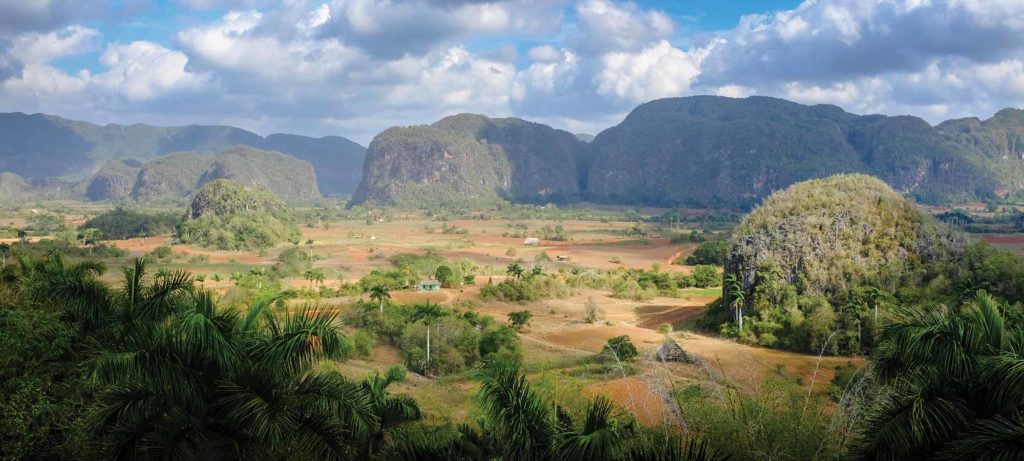
The Quince Amor crew was fairly well divided between experienced sailors and first-timers. Green was our designated captain and devised a watch schedule that paired the saltier crewmembers with those less experienced. Our crossing started out easy enough, but as the moonless night went on, the wind increased to about 20 or so knots with confused seas. A Saba 50 is a big boat, and a far cry from the classic ketch I’m used to sailing. Helming from the flybridge while barreling along through the Gulf Stream in the dark of night was quite the experience. Throw in some ship traffic and boat systems that we were all still getting used to (not to mention a few seasick crewmembers), and there were some tense moments. Needless to say, we were all happy for daylight and our first sight of Cuba’s coastline.
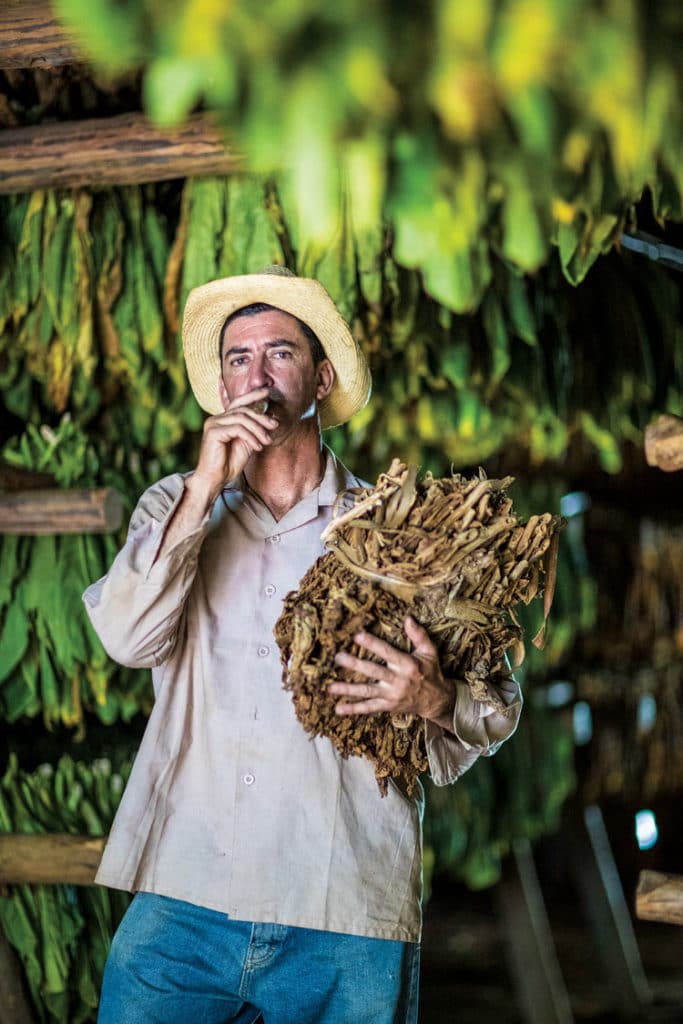
On the approach to the Marina Hemingway entrance, we caught up with some other rally boats (so much for not inundating the officials) and queued up outside the channel, where a red powerboat zoomed up to each boat to tell them when it was their turn to head in. The entrance itself is a bit tricky, with a reef on either side of the channel, then a sharp turn to port to land on the customs dock. Clearing into Cuba was a simple affair, and included a round of visitors — customs and agriculture officials, a doctor and drug-sniffing dogs — all of whom were very polite.
Afterward, we each had our picture taken and passport stamped (if we wanted). As I walked back to the boat from the customs office, I noticed an odd little statue. A figure of an animal that resembled a gopher or a giant guinea pig stood about 3 feet high right on the seawall. I climbed back aboard and mentioned it to Jon, who was next for his passport stamping. Jon might not know more Spanish than I do, but he’s definitely more confident, so he had no trouble asking someone on the dock about the significance of the statue. “Ahhh … ratón. It’s a very important animal here in Cuba, and very good to eat,” was apparently the reply. Jon relayed this surprising answer to me, and at first I didn’t believe him (thinking his translation might be off). But after reading in my guidebook a bit, I learned that, indeed, a large rodent, technically a hutia, was once hunted for food. Or the dock guy might have been messing with us.
Marina Hemingway is huge and unlike any marina I’ve been to before. Instead of docks and slips, boats side-tie along four canals. For the most part, each dock space has electricity and water, though the conditions of the concrete docks vary, so we heeded advice and used plenty of fenders. Once we secured Quince Amor and raised our Cuban courtesy flag, it hit me that we were actually in Cuba.
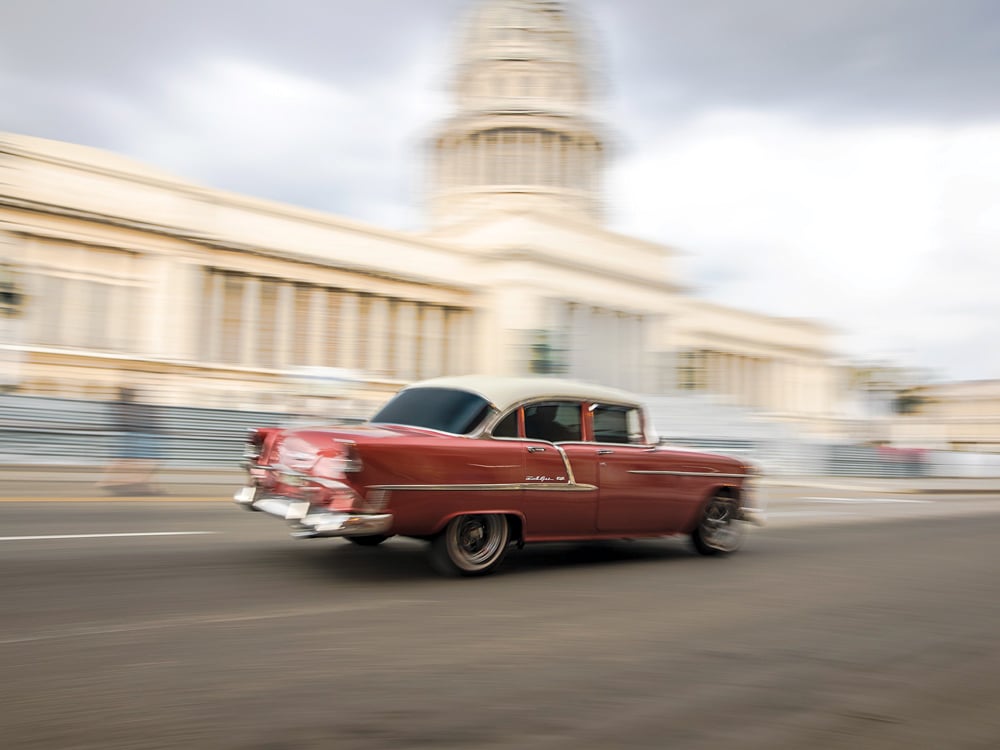
When I think of Cuba, certain images tend to come immediately to mind: rum and cigars, Che and Fidel, crumbling old Havana and, of course, the classic cars, all with tunes from the Buena Vista Social Club playing in the background. Cliché, I know. I had assumed before we arrived that we’d probably see all of these things, but I wasn’t prepared for how much. I’d thought that the old American cars would be few and far between, so I was floored when I spotted one zooming by right after we’d tied up. Turns out, they are everywhere, in all their pieced-together, noxious diesel-fumed glory (most of the original gas engines have long since been replaced).
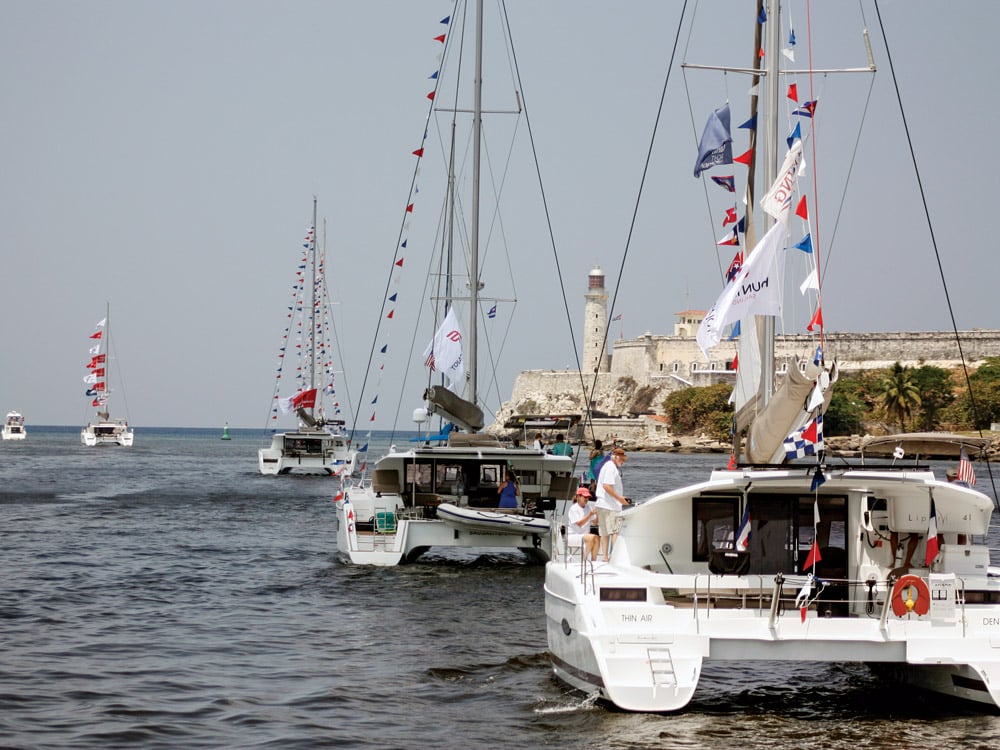
It was already late in the day, and we were all eager to get off the boat to explore and hopefully find dinner. Our rally organizers had suggested that crews eat aboard their boats that first night, but we were feeling adventurous, and David said he knew of a small place nearby that would be perfect. Marina Hemingway is outside of Havana proper and within walking distance of a neighborhood called Jaimanitas. I have an absolute love of Cuban cuisine, so local fare was very much on my mind. After a few wrong turns, David thought he found the right place, though there was no longer a restaurant there. We walked for a few more blocks, then came across a small paladar that looked promising. The streets we were wandering down weren’t the type that were frequented by tourists, and the neighborhood restaurant we stopped at was really nothing more than maybe six tables and a counter, with locals coming in and out. Green, David, Sandy, Jon and I found a table and ordered Cristal, a Cuban beer. The meal was simple and affordable, and perfect for our first night in Cuba. After we had been there for a little while, a man walked in with a motorcycle helmet under his arm, and he clearly looked like he was picking up some dinner on his way home after a long day at work. Jon, who isn’t shy at all and will talk to anyone, struck up a conversation and invited him to sit with us while he waited for his food. He introduced himself as Octavio Cesar. He was eager to speak English with us, and was enthusiastic to chat with Americans about rock-and-roll. After a few minutes, he said, “You know Bon Jovi, right? Well, I met him, right here last year!” To prove his point, he took out his cellphone to show us some photos, and yes, there he was, with Bon Jovi. Unexpected indeed.
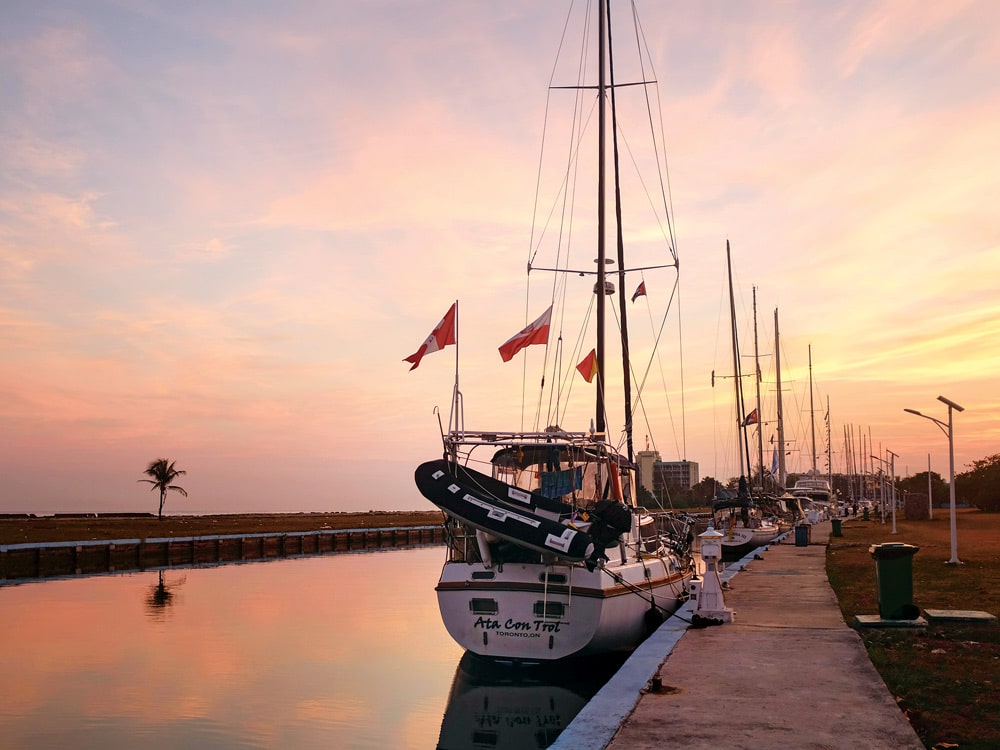
For our first full day on the island, everyone participated in a welcome-to-Havana tour. Organizers broke up rally crews into seven groups, each of which left the marina aboard modern, comfortable buses. A guide on the bus pointed out the sights along the way, including the Hotel Nacional de Cuba and the U.S. Embassy. Once we arrived in Havana, we met with another guide and took a walking tour of the old city. So much of Havana was exactly like I expected — from photos I knew that many buildings would be in disrepair, if not outright crumbling down, but what I didn’t expect was the art, everywhere. Statues, murals, sculptures, music, quotes from José Martí — you name it. Art, be it visual or performing or the written word, is a big deal in Cuba (although art supplies, such as quality paints and paper, are scarce).
A highlight of our time in Havana was meeting Solé, an artist whom David had befriended on a previous trip. We found his colorful open-air studio tucked on a side street. With an easy smile and a look that would fit right in on a California beach, Solé was happy to show us around his shop and chat about his art. His pieces ranged from portraits of Che Guevara and Bob Marley to Cuban flora and fauna.
The next day was the Cruising World Parade of Boats into Havana harbor, which was something that all rally boats had to participate in because it was one of the event’s conditions for legal travel to Cuba. We lucked out with the weather — light wind and a perfectly sunny sky. I’ll admit that I’ve been in boat parades before (usually the Christmas variety), and was a bit lukewarm at the thought of spending the day on the water when we could have been exploring. I couldn’t have been more wrong.
Organizing 60 boats to leave the marina, check out with customs, line up in a specific order and then cruise down the coast to enter Havana harbor (then do all that in reverse) must have taken someone hours to orchestrate. It all went off surprisingly well, with the most challenging part being lining up in order. Commodore Escrich, of the Hemingway International Yacht Club, led the parade on his Sea Ray, and each boat was decorated with as many flags as it could fly. I underestimated how cool it would be to take in Havana from the water as we motored the length of the Malecón — the colonial buildings, the classic cars going by, the distinctive Russian embassy and people lining the shore to watch the boats. But the best, most goose-bump-raising part of the parade happened as we approached El Morro castle and our turn into Havana’s harbor — a lone Cuban musician playing The Star-Spangled Banner on his trumpet as we all passed by. The return trip to the marina turned out to be a fantastic downwind sail, with many of the boats popping their kites for the run. It truly was a beautiful day in all respects.
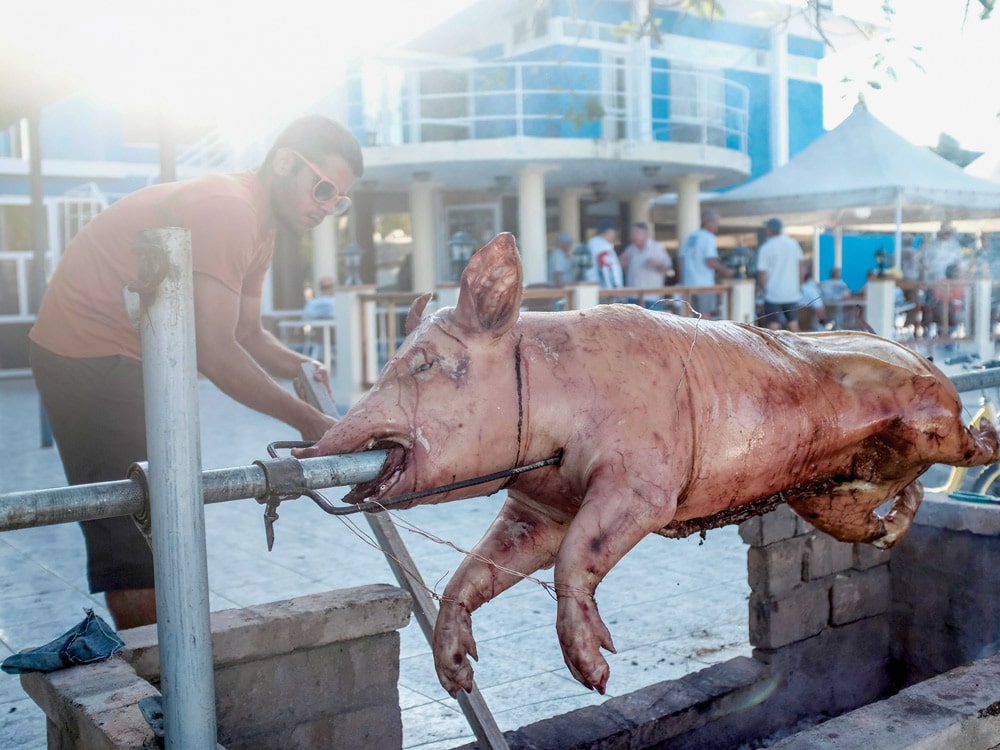
That night was the first of two rally parties, and this one was held at the yacht club. After a welcome from the commodore and some prize giving, the crowd enjoyed a Cuban pig roast and plenty of rum. One notable prize —the Comeback Award — went to Shenanigan, a Gulfstar ketch captained by Jennifer Lamar and Janet Ellis. On their way to Key West from Charleston, South Carolina, the pair was hit with some nasty weather, and the mizzen boom broke. Fortunately, the replacement arrived in Key West just before Shenanigan was about to push off for the rally.
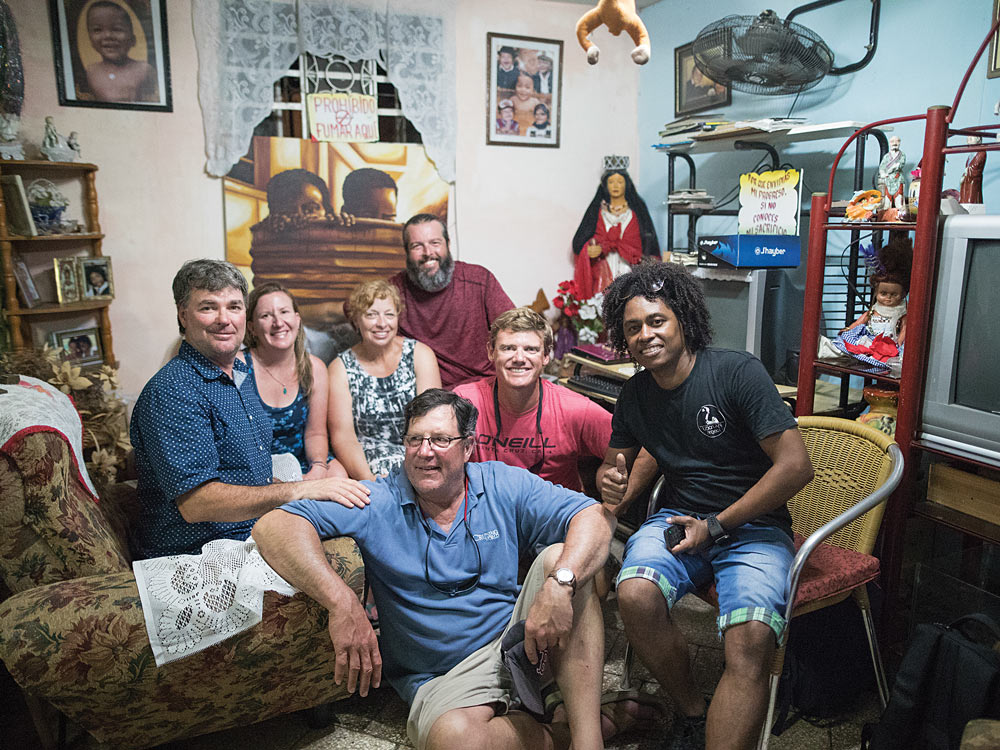
Due to the red tape involved in coming and going into Cuban ports, Cuba is much easier to tour by land, especially if you have time constraints. Over the next three days, there were a variety of tours and activities that rally participants could choose from, including an in-depth look at the Cuban revolution, a visit to a coffee plantation and salsa-dancing instruction, in addition to further exploration of Havana.
After our initial day in the capital, the crew of Quince Amor couldn’t wait to get back there. Travel within Cuba is an adventure in itself, especially when you catch a ride in one of the many classic cars turned taxis. Our driver that morning was surprisingly outspoken about, well, everything. (His opinion of the Castros and all politicians? They’re bad. Although he used much, much more colorful language.) His car had been in his family for nearly 60 years, and he kept it in better condition than the majority of the “Yank tanks” that we saw on the road.
First order of business in Havana? Finding lunch, which we did at a great spot we stumbled upon. While the ropa vieja was tasty and the beer nice and cold, the highlight of the meal was the private concert from a trio of musicians playing classic Cuban tunes with guitars and maracas.
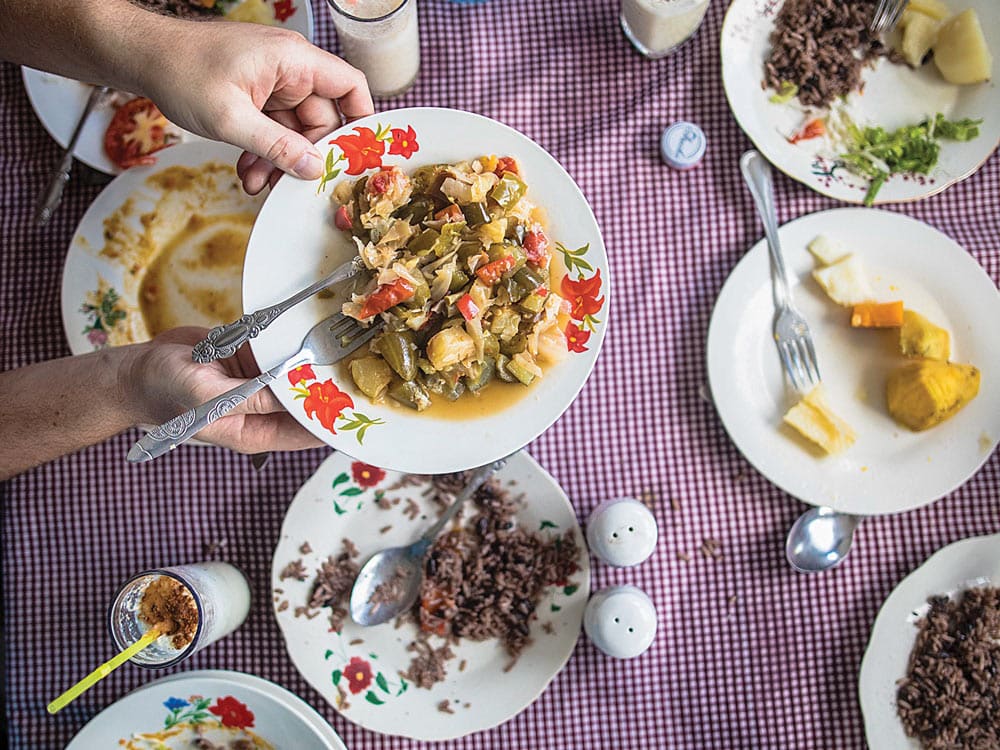
Having no use of our cellphones for the week meant navigating the streets of Havana the old-fashioned way — with a map and a guidebook and plans to meet at specific places at certain times. Honestly, taking a tech break was refreshing, and getting lost in Havana can yield sweet surprises. There is nothing quite like wandering until some music lures you in, whether it’s on a street corner or in a bar, or coming across yet another cool art gallery. The temperatures outside truly rivaled those on the surface of the sun, so finding respite in an icy mojito or two could be considered therapeutic.
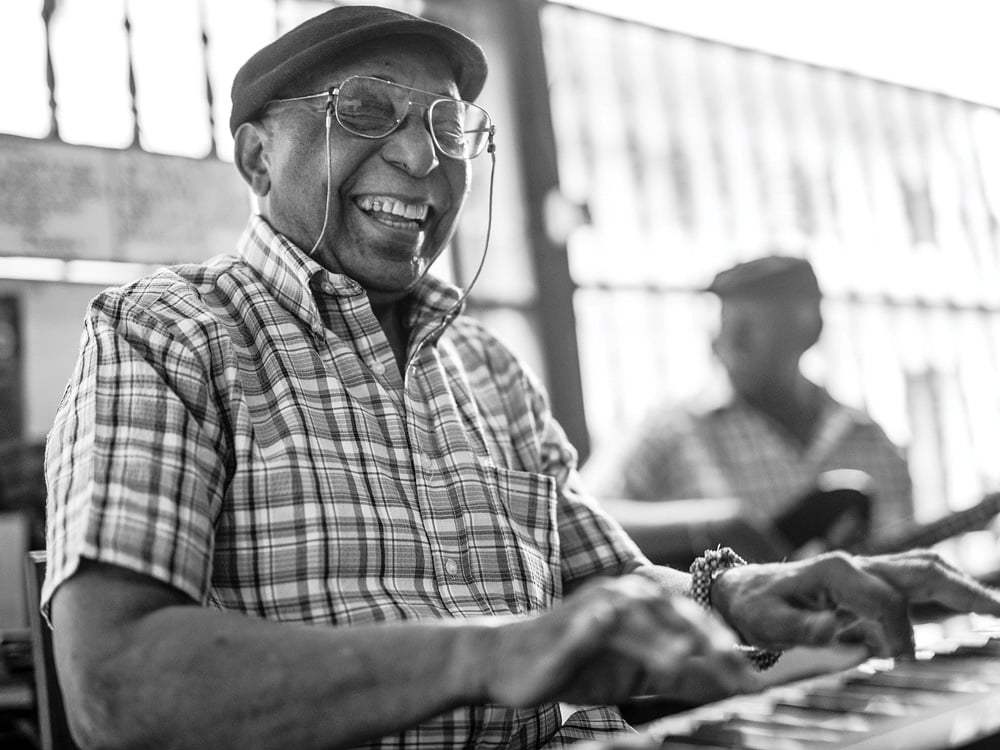
There isn’t much in the way of shopping in Havana, and our planned souvenirs leaned heavily toward rum and art. Later in the day, we all headed back to Solé’s studio, where I bought a lovely painting of a hummingbird. The big group of us, now including Solé and his wife, Mary, decided to make an evening of it and had a fine dinner in town followed by dancing to a live salsa band. Solé and Mary then invited all of us back to their apartment for coffee, an unexpected treat. In any other city, the walk there through a labyrinth of dark alleys would likely have raised some internal red flags, but not here. Each of us at some point on the trip had remarked how surprisingly safe we felt wandering Havana.
Seated around the small, tidy living room, we chatted about our families as best we could given our language barriers. Mary, a photographer, was excited to show Jon her equipment and use his much more modern Canon. The coffee was strong and delicious (maybe not the best decision at 11 p.m., but whatever), the company good and the music, well, the Simply Red tunes were a throwback for sure.
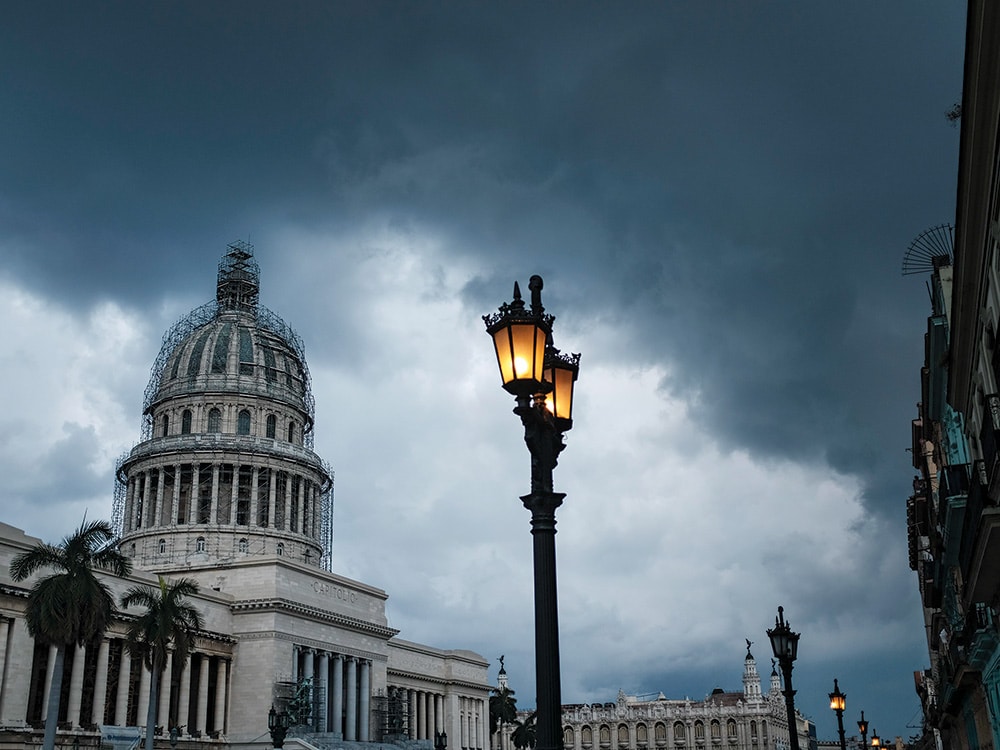
It’s hard to get a feel for all of Cuba if you only stay in Havana, so Jon, Green and I were glad to have the opportunity to head out of town on the rally’s trip to Viñales. This small town was a two-and-a-half-hour drive west from the marina. Once outside of Havana’s sprawl, the scenery rapidly changes to a much more rural landscape. While I had a notion of what I thought Havana would be like, I had no idea what to expect in any other part of the country. The only word to describe the Viñales valley is spectacular: mountainous and dotted with dramatic steep-sided limestone hills called mogotes, and the sweet smell of tobacco, the region’s dominant crop, permeates the air. We visited the impressive, if strange, Mural de la Prehistoria, a 400-foot-long painting on the side of a mogote that is supposed to illustrate evolution. After an extraordinarily sweaty hike, the air-conditioned bus felt amazing. Better yet, our tour guides candidly talked with us about everyday life in Cuba, and were happy to answer any of our questions. I was surprised that no subject was off limits. We learned about the education system, and how the dual currencies work (see “Money Talks,” at the end of this story) and have changed the economy. They told us about the types of jobs Cubans want (anything with the potential to work with visitors and earn convertible pesos) and spoke of travel, religion, politics — pretty much everything.
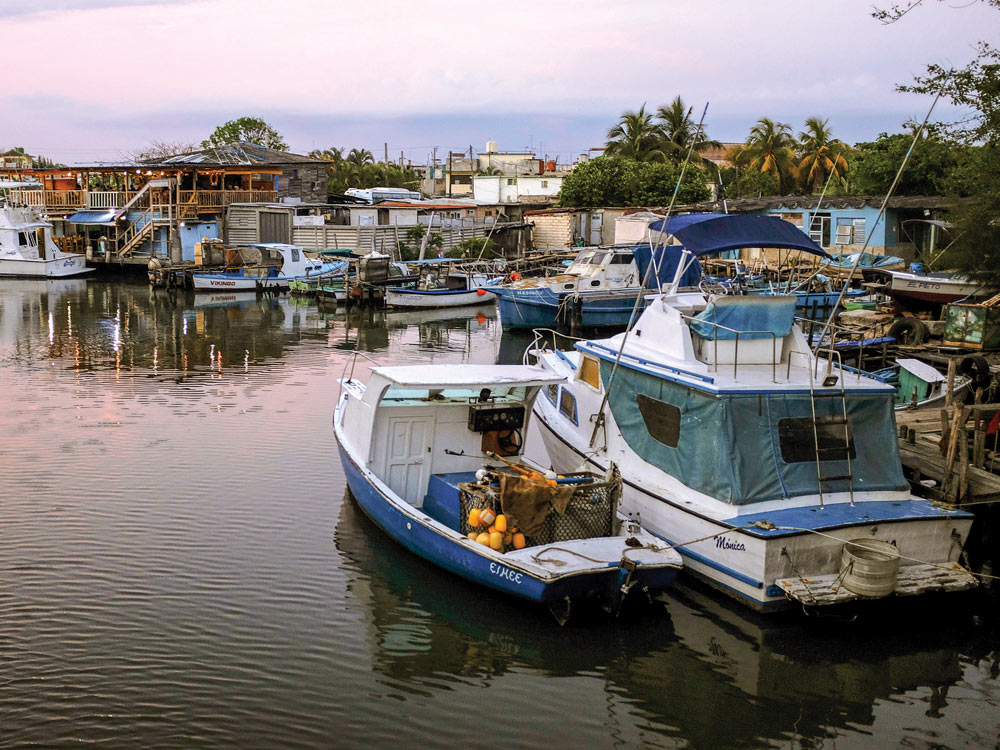
Lunch this day was easily the best meal we had in Cuba. We ate at an organic farm named Casa de Confianza that served direct field-to-table fare, family style. The dishes were abundant and delicious: veggies, pork, chicken, seafood, rice, beans. The signature drink — a healthier take on a piña colada — was served with a bottle of rum on the table for guests to spike to taste.
On our final day in Cuba we paid a visit to Havana’s Museum of the Revolution. The imposing building was once the presidential residence but now provides an interesting (albeit one-sided) education of the Cuban revolution. Afterward, sounds from a fantastic band pulled us into another cafe for more mojitos. It was the perfect cap for the afternoon, since we needed to be back at the marina in time for the last rally party.
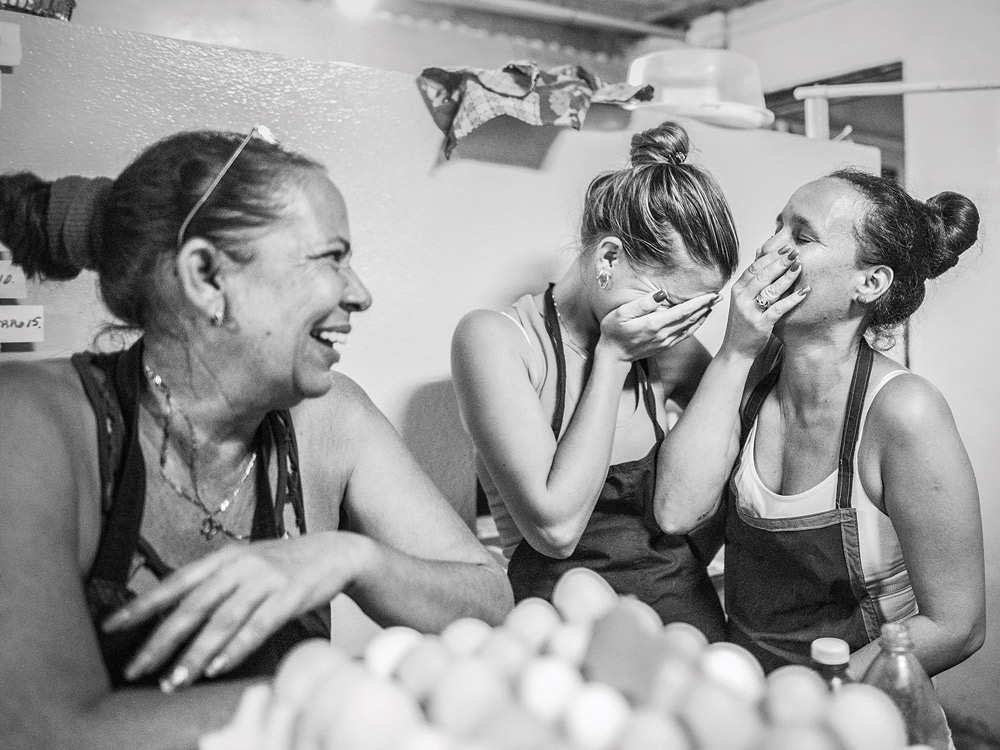
The rally fleet was scheduled to head out the next day, but due to a weather report that warned of building northerly winds, several crews planned to leave that evening. The Quince Amor crew debated leaving later that night, but decided that an early morning departure would be fine. The closing party was held on the marina grounds and featured a sit-down dinner under the starry night and live music, a special way to close out an incredible time.
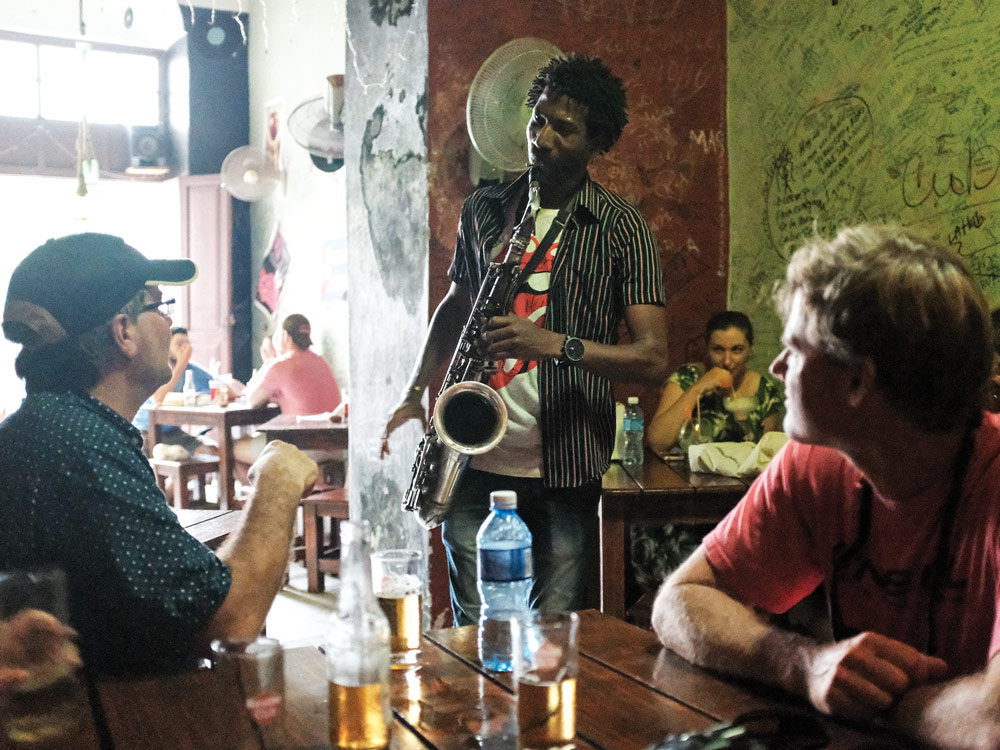
Under still dark skies, it was with a heavy dose of reluctance that we cast off for home. In the end, Quince Amor‘s journey back to Key West was as benign as the voyage there was boisterous. Dolphins accompanied us for a portion of the way, and the guys even went for an ocean swim. All too soon we were back where we started, but now with old friendships deepened, new ones formed and memories galore. Summing it up would require too many superlatives, so I’ll leave it at this: Cuba blew my mind, and my expectations. And I barely scratched the surface.
Jennifer Brett is CW’s senior editor.
Money Talks
One of Cuba’s more unique features, and a source of bafflement for visitors, is its two-currency economy. The Cuban peso (CUP) is the national currency of Cuba and what most state workers are paid their wages in. The Cuban convertible peso (CUC) has a value that is pegged to the U.S. dollar and is worth about 25 times more than the CUP. Cash is king in Cuba (credit and debit cards issued from American banks don’t work), so luckily, it doesn’t take long to get the hang of it. Before leaving the United States, we exchanged dollars for euros, which have a higher exchange rate for CUCs, and then bought our CUCs when we arrived. Most of the things you’ll spend money on are priced in CUCs (restaurants, taxis, dockage), while basics, such as street food, produce and coffee stands, are priced in CUPs. Some stores accept both currencies and list two prices. Just be sure you’re using the correct bills or coins.








